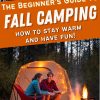How to Plan a Fall Camping Trip That Actually Feels Fun
This post may contain affiliate links.
Fall camping is one of our favorite ways to squeeze every last drop out of the season. Crisp mornings, quiet trails, and the smell of campfire smoke drifting through colorful trees — it’s hard to beat. But fall also brings cooler nights, earlier sunsets, and changing weather. In this post, we’ll walk you through everything you need to know to stay warm, safe, and comfortable so you can stretch your camping season well into autumn.
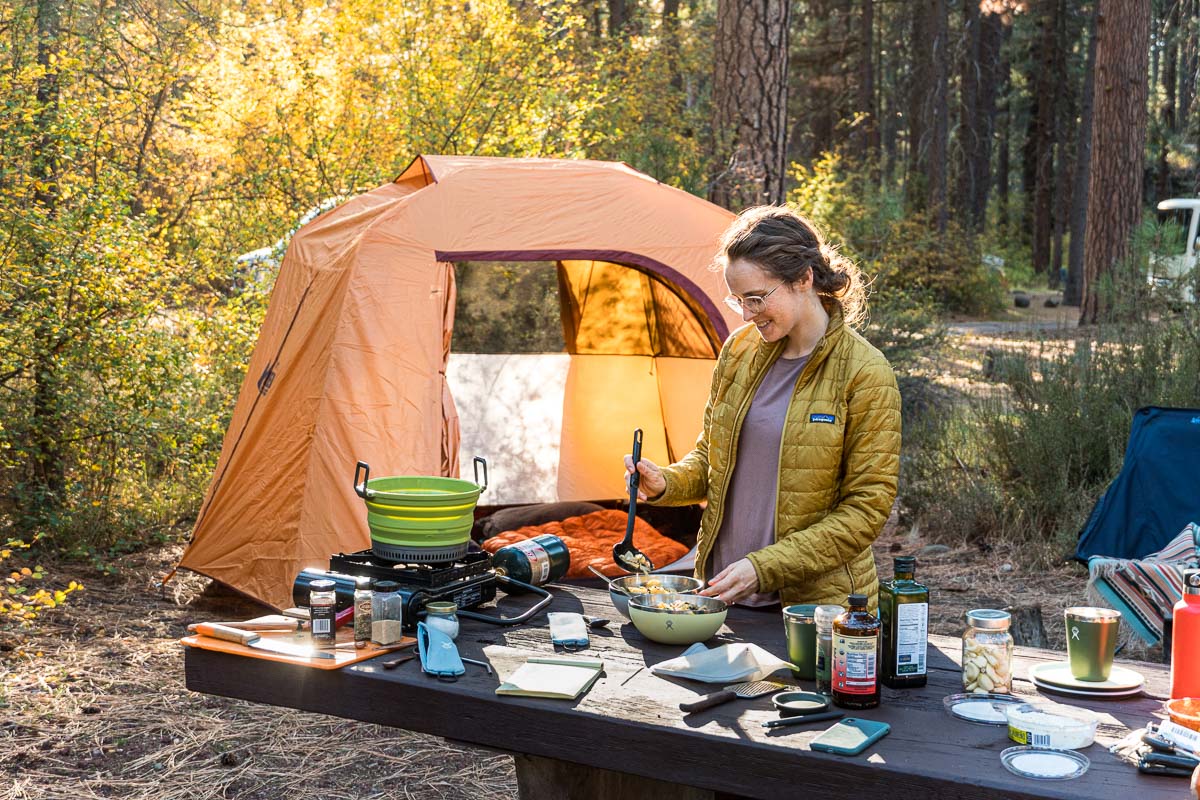
Fall is our favorite time of year to go camping. Campgrounds are far less crowded after Labor Day, the temperatures are pleasant during the day and cool at night, and bugs have all disappeared! Besides, autumn is such a wonderful season to be outdoors.
After a hot and sticky summer, the cool air of fall can feel like an absolute relief. It actually feels good to be outside again. Now going on a hike doesn’t need to be a complete sweatfest and making a warm campfire actually sounds cozy.
There’s a lot to see on a fall camping trip too! Fall foliage is one of the most spectacular displays in the natural world. Leaves bursting into reds, oranges, and yellows. And going on a camping trip is one of the best ways to experience the event firsthand. Stay out to watch the sunset filter through the leaves, or wake up early to catch the first glow of morning lighting up the forest. It can be magical.
While there is a lot to get excited about when it comes to fall camping, there are also a few unique challenges you may not face during the summer. The potential for inclement weather, staying warm, and shorter daylight hours are just a few things you will want to think about ahead of time.
But don’t worry, we cover everything you need to know below. By the end of this article, you’ll be ready to get out there and have a fantastic fall camping trip!

Planning your fall camping trip
Planning a fall camping trip takes just a little extra forethought compared to summer. Here are a few quick steps to help you pick the right time, place, and setup for a your autumn adventure.
Use a Fall Foliage Map
Want to catch peak leaf-peeping season? Start with this interactive fall foliage map. This map is updated every year using weather data from spring and summer, so you’ll have a pretty good idea of when your region will be showing off its best colors.
Call the Local Ranger Station
Ranger stations can provide a ton of local info you won’t find online. You can ask about current foliage conditions, nearby hikes with the best views, and which campgrounds are open. You’ll need to call during their limited daytime hours and actually talk to a human, but you’ll get a ton of helpful, detailed advice.
Book a Campsite
One of the perks of fall camping is that reservations are much easier to snag. After Labor Day, campgrounds aren’t usually as crowded, so you may find openings just a few weeks (or even a few days) before your trip.
Confirm Campground Openings
If you’re not reserving ahead of time, double-check that your campground is still open. Some sites begin shutting down after Labor Day, and some closures depend on weather. Check online first, and if it’s not clear, call to confirm before you hit the road.
Consider a Campervan or RV
Cooler temps make fall the perfect time to try out a van or RV. You’ll stay warm, dry, and a little more comfortable if the weather turns. Rentals are widely available on sites like Outdoorsy or RVshare.
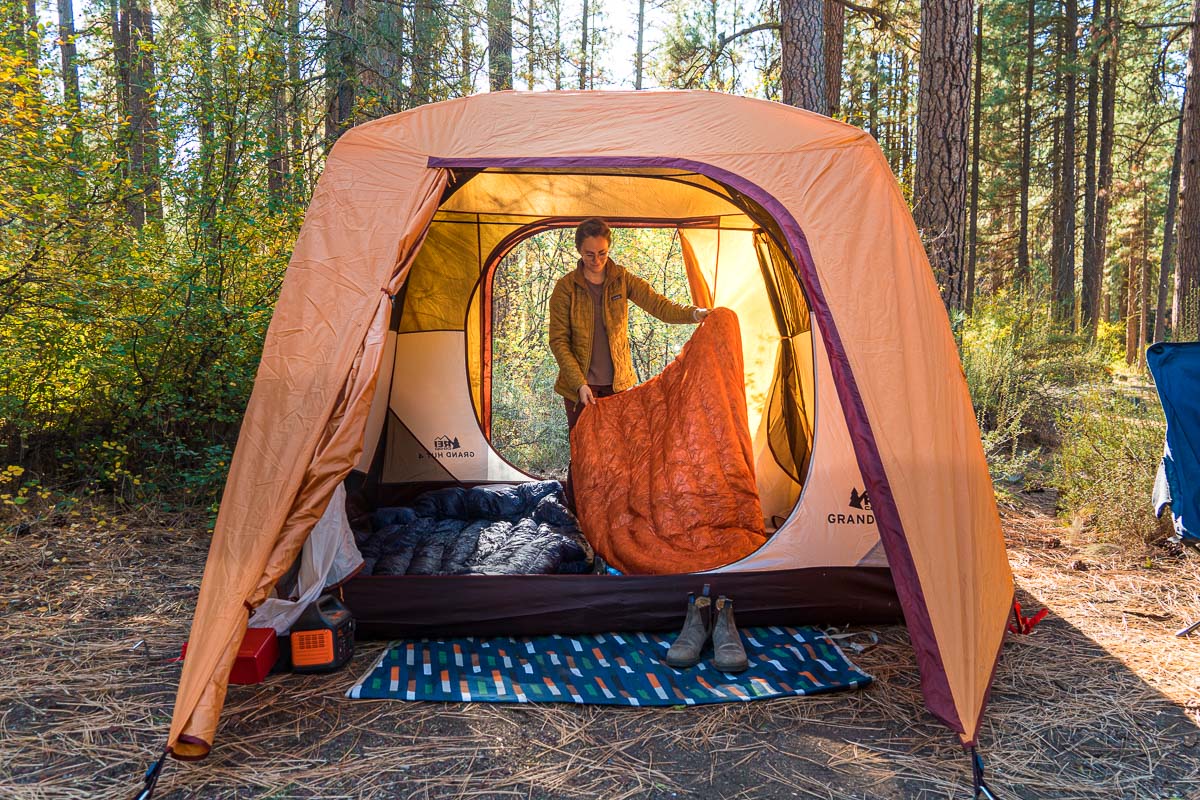
Fall camping essentials
Most of your summer gear still works in the fall, but cooler nights, shorter days, and wetter conditions mean a few smart upgrades can make your trip way more comfortable. Below are some of what we would consider must-have fall camping gear:
- Tent with Rainfly and Footprint: Choose a tent with a full-coverage rainfly and plenty of interior space (helpful if you’re stuck inside due to rain, or want to hang out after dark!). If your tent came with a footprint or ground sheet, be sure to bring it. If not, you can easily make your own.
- Sleeping Bag: Pick a sleeping bag rated at least 10ºF below the lowest expected temps (15–20ºF if you run cold). Layer on a fleece or silk sleeping bag liner or top quilt for another 5–10ºF of warmth.
- Insulated Sleeping Pad: We recommend a pad with at least a rating of R-4 in the fall (please leave your un-insulated air mattress at home!). This is our favorite pad that is so comfortable, and this is a great 2-person mattress. To increase the R-value of your sleeping pad, you can add a foam pad underneath.
- Tarp or Rain Shelter: Pitch one over your picnic table so you have a dry, protected spot for cooking or hanging out if it rains.
- Camp Chairs + Sit Pads: A chair with padding will offer a little more warmth while hanging out, and foam pads or a cushion on your picnic bench can make chilly mornings and mealtimes much more comfortable.
- Extra blankets: So many uses! I loved snuggling up in my Rumpl with my kiddos on our last trip.
- Camp Stove: Bring a reliable camp stove with a built-in windscreen or add a folding windshield to keep your flame efficient.
- Extra Fuel: Colder outside temperatures means longer cook times. Also, don’t let the fear of running out of fuel prevent you from making another cup of hot coffee or cocoa on a chilly morning!
- Hatchet + Fire Starter: If fires are allowed, fall is the perfect time to build one. It can really extend the evenings and make chilly mornings feel cozy. Bring a small hatchet for splitting wood and reliable fire-starting materials.
- Headlamps or Lanterns: Shorter days mean you’ll need a way to see around camp after dark. Headlamps are great for hands-free tasks, while lanterns light up your cooking or hangout area.
- String Lights: Nothing sets the dreamy, Instagram-able vibes like a set of twinkle lights strung around camp or on your tent.
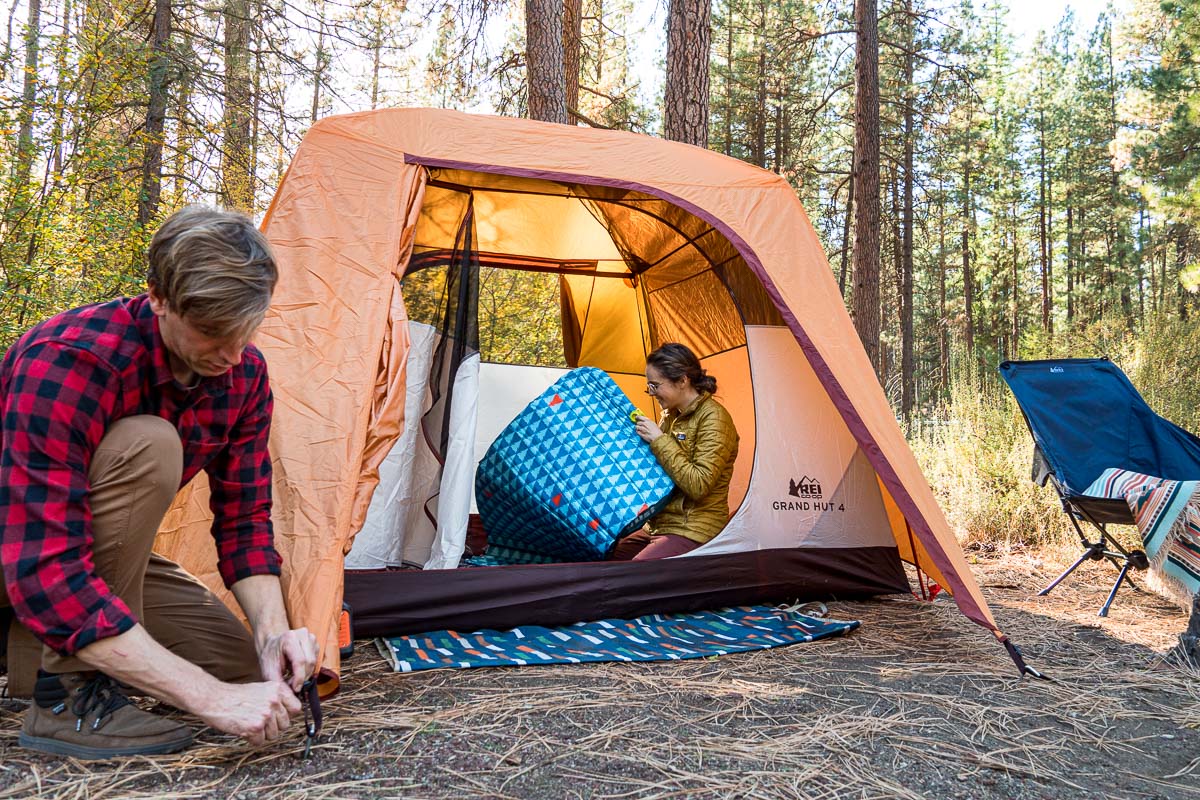
Tips for setting up camp
In the summer, you can get away with throwing your tent up just about anywhere. In the fall, though, a little extra planning goes a long way toward keeping your campsite warmer, drier, and more comfortable. Here’s what to keep in mind:
Arrive Early
Plan to get to camp with plenty of daylight left. Fall sunsets come quickly, and no one likes setting up a tent by headlamp! Plus, you’ll have time to explore the campground and get your bearings before dark (trust us, finding the pit toilet in the pitch black is not the way you want to kick off your trip).
Choose a Smart Site
If wind is in the forecast, pick a spot with natural shelter: behind trees, bushes, a boulder, or even your car. Higher ground is your friend: cold air settles in low spots, and water pools there too. Avoid pitching your tent under dead branches (“widowmakers”), which can fall in windy conditions.
Think About Rain + Frost
Use a tent footprint or groundsheet (cut slightly smaller than your tent floor) to keep water from seeping in. If frost is likely, look for a spot that will get early morning sun to help warm things up and dry your tent faster.
Pitch Your Tent for Ventilation
Even on cold nights, crack tent vents or doors slightly to reduce condensation. Position the door away from the prevailing wind to keep the interior drier and warmer.
Create a Covered Hangout Space
Set up a tarp or rain shelter over your picnic table so you have a dry place to cook, eat, and relax if it rains. Angle one side down to shed water and block wind.
Light Your Site
Fall nights get dark fast. Use reflective tape on your guyline and stakes so no one trips after dark, and set up lanterns or string lights early to make camp feel welcoming once the sun sets.

Clothing for autumn camping
Fall days can feel mild and sunny, but nights often dip close to freezing, even if the forecast looks pleasant. The key to staying comfortable is bringing plenty of layers so you can add or remove warmth as needed. You can always peel off a layer, but you can’t put on what you didn’t pack!
Layering basics
Think of your clothing like an onion: several layers you can add or shed as temps change throughout the day.
- Base Layer: This layer sits next to your skin and wicks away moisture to keep you dry (and therefore warmer). Choose merino wool or synthetic fabrics — avoid cotton, which traps sweat and can make you cold. We personally like Smartwool merino tops and leggings.
- Mid Layer: Adds warmth by trapping heat. This could be a fleece sweater, a lightweight grid fleece, or a lightly insulated jacket. Patagonia’s Better Sweater or Synchilla Pullover are great choices.
- Insulating Layer: For when the temperature really drops. A puffy jacket is perfect! We love REI’s 650 Down Jacket and Patagonia’s synthetic Nano Puff.
- Outer Shell: A windproof, waterproof shell traps body heat and blocks wind, rain, and even early snow. The REI Rainier Jacket is a solid, affordable option.
Pro tip: Avoid sweating during activities or camp chores. If you start to heat up, remove a layer before you get too sweaty. Damp clothing can chill you quickly once you stop moving.
Additional clothing for fall camping
- Rain Gear: Fall weather can be unpredictable, so we bring rain gear even if the forecast looks clear.
- Warm Socks: Wool or synthetic socks keep feet cozy, but make sure they’re not so thick that they make your boots too tight (restricted circulation = cold feet). Bring at least one extra pair just for sleeping.
- Waterproof Boots or Shoes: Keep feet warm and dry in wet conditions.
- Warm Hat or Beanie: A must for chilly mornings and evenings.
- Buff, Gaiter, or Scarf: Great for cutting wind or adding just a bit more warmth when temps dip.
- Gloves or Mittens: Layer with glove liners for dexterity if you need to cook or set up camp.
- Cozy Pajamas: Always change into dry clothes before bed. This keeps sweat and moisture out of your sleeping bag and helps you sleep warmer.
- Extras of Everything: Socks, hats, gloves, and even a spare mid-layer. Fall camping can be wet, and backups are essential.
Pro tip: Don’t just pack for the lows! Daytime temps can still be very warm, especially in lower elevations, so be sure you’re packing for the daily highs as well.
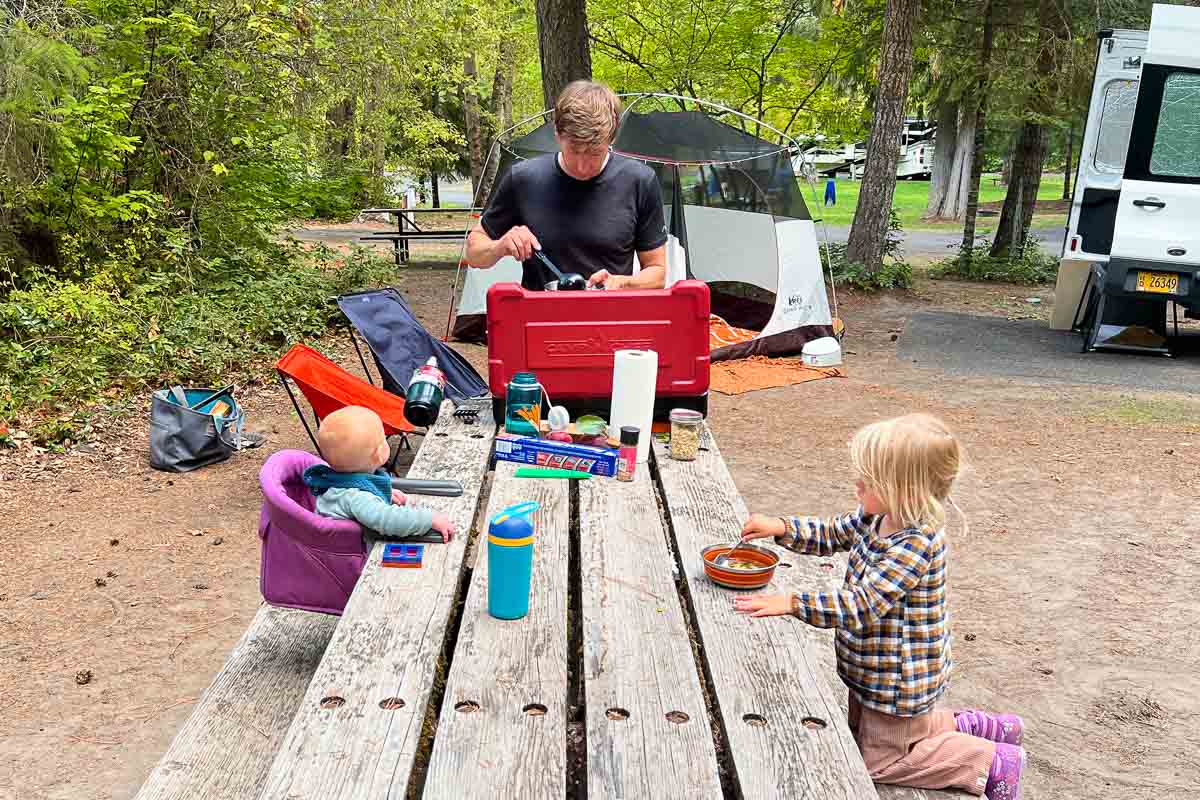
Camping with kids in the fall
Camping with kids is always an *adventure*, and fall brings its own set of challenges. Cooler nights, shorter days, and unpredictable weather mean you’ll want to make a few adjustments so everyone stays safe, cozy, and happy.
Pack the Right Sleep System
- Extra Layers for Sleep: Kids don’t regulate body heat as well as adults, so pack warmer pajamas, hats, and socks specifically for nighttime. For babies, a fleece or down sleep sack works well (we’ve used a TOG 2.5 sleep sack and also have a baby-friendly sleeping bag). Older kids may be more comfortable with an insulated blanket or quilt layered on top of their sleeping bag.
- Comfort Items from Home: Bring along a familiar blanket, pillow, or stuffed animal from home to help kids settle into a new sleep environment.
Keep Them Warm and Dry
- Daytime Layers: Dress kids in moisture-wicking base layers, fleece or insulated mid-layers, and a waterproof shell. Wool socks and waterproof shoes or boots are essential for keeping feet warm and dry.
- Pack Backups: Always pack extra socks, gloves, hats, and at least one spare warm outfit for each child. If something gets wet, you’ll want a dry backup ready.
- Warm Up in the Car: If your kids start getting really cold, take a loop around the campground in your heated car. One of my core camp memories is doing this with my mom and sister at the Grand Canyon when we unexpectedly woke up to snow!
Adjust the Camp Routine
- Arrive Early: Getting to camp with daylight to spare is especially important with kids. It gives them time to explore safely and helps you get everyone settled before dark.
- Plan Kid-Friendly Activities: Early sunsets can leave little ones restless. Pack a few easy games, coloring books, or a favorite bedtime story to keep evenings fun and low-stress after dark.
- Nap Time Logistics: Naps can be super challenging when camping. Give yourself a little grace, and stay flexible! We drape a large blanket over the tent to make it darker for our toddler. If your kiddo falls asleep easiest on the move, plan for a stroller nap around the campground, or take a scenic drive during naptime.
- Stay Flexible: If the weather turns bad or it’s just too cold, don’t hesitate to cut the trip short or spend a night in a hotel or cabin. Research your bailout options before your trip so you’re not left scrambling, especially if you have limited cell service!
Safety First
- Campfire Rules: Establish clear boundaries around the fire. A safe “no-go zone” can be marked with sticks or rocks so kids know where not to cross.
- Nighttime Visibility: Headlamps and reflective clothing help kids move safely around camp once it’s dark. Glow sticks are another fun and useful option.
- Bathroom Breaks: Cold nights make those middle-of-the-night potty runs extra challenging. If you have a toddler like we do, bring a small potty to keep next to your tent make things easier.
Pack Plenty of Snacks
- Snacks: Burning calories keeps kids warm (and their tummies happy!). Pack high-calorie snacks like cheese, trail mix, nut butters. Easy to eat snacks like pouches and fruit bars are also great, packable options. With the new environment and all things to explore, we’ve had better luck with the all-day-grazing approach rather than hoping they focus for long enough for an actual meal time.
- Warm Drinks: A thermos of hot cocoa, herbal tea, or warm milk can kids warm up from the inside out.
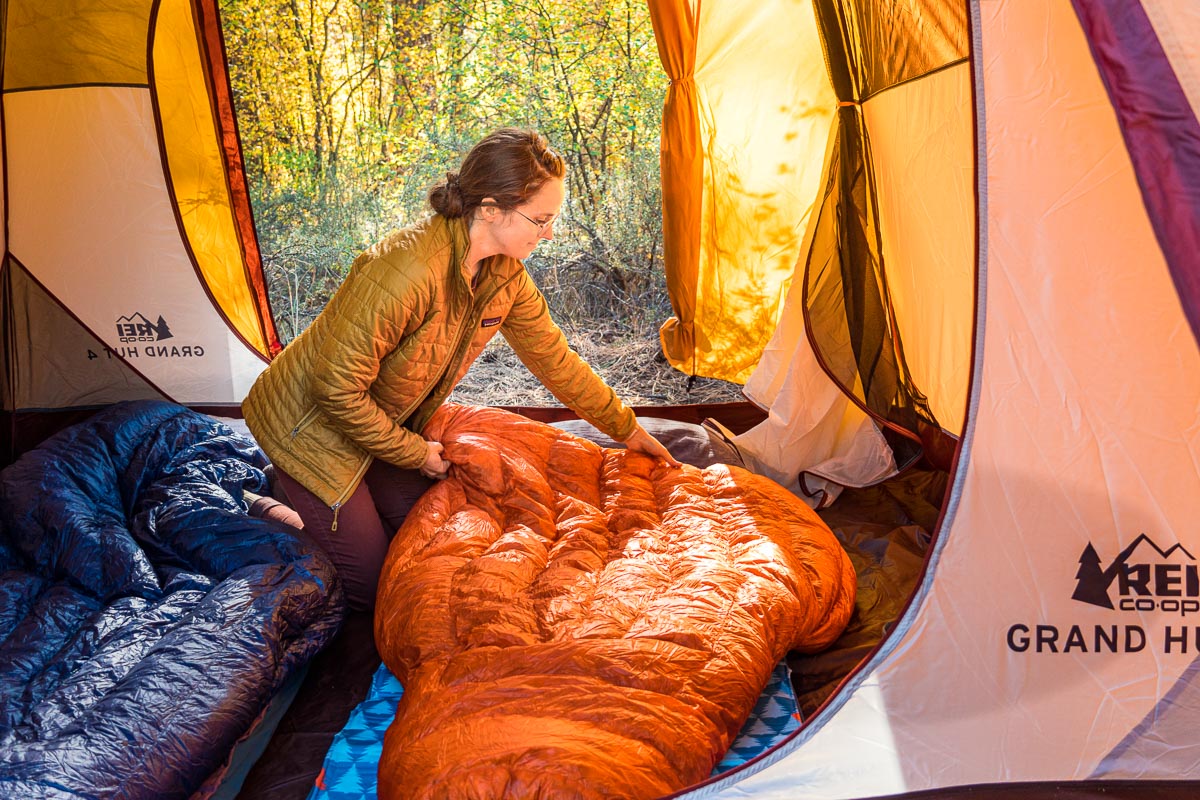
Staying warm while camping in fall
“How do I stay warm?” is one of the most common questions we get about fall camping, and for good reason! Chilly nights can make or break a trip. The good news is that with a few smart habits and gear tweaks, you can stay cozy and actually enjoy the evening.
Layer Up Early
Start warm and stay warm. Dress in layers as soon as the sun sets so you’re not trying to play catch-up once you’re already cold. Avoid cotton and stick with merino or synthetics that wick moisture and keep heat in.
Keep Moving
Plan active daytime adventures like hiking, biking, or chopping firewood to keep your core temperature up. At camp, do a quick set of squats or jumping jacks before climbing into your sleeping bag.
Build a Warm Sleep Setup
- Insulate from Below: Use an insulated sleeping pad with an R-value of at least 4.
- Boost Your Bag: Use a sleeping bag rated 10–15°F colder than the forecast or add a fleece/silk liner for another 5–10°F of comfort.
- Sleep Clothes: Change into dry clothes at night to keep moisture out of your bag.
Body Heat is Your BFF
- Go to Bed Warm: Move around a bit before bed. Do jumping jacks to warm up, then crawl right into your sleeping bag.
- When Natures Calls, Answer! If you have to pee in the night, go. A full bladder uses up body heat and will make you colder.
- Plan Ahead: Tuck tomorrow’s clothes inside the bag so they’re warm when you wake up.
- Wake Up Warm: Before crawling out of your sleeping bag, do a few crunches to warm up. Once you’re outside, a quick set of jumping jacks will get your blood pumping.
Pro tip: If it’s safe to do so, a campfire is always a winning way to bring warmth to your campsite. It’s a great motivator to get you out of bed in the morning, and makes the darker evenings much more enjoyable.
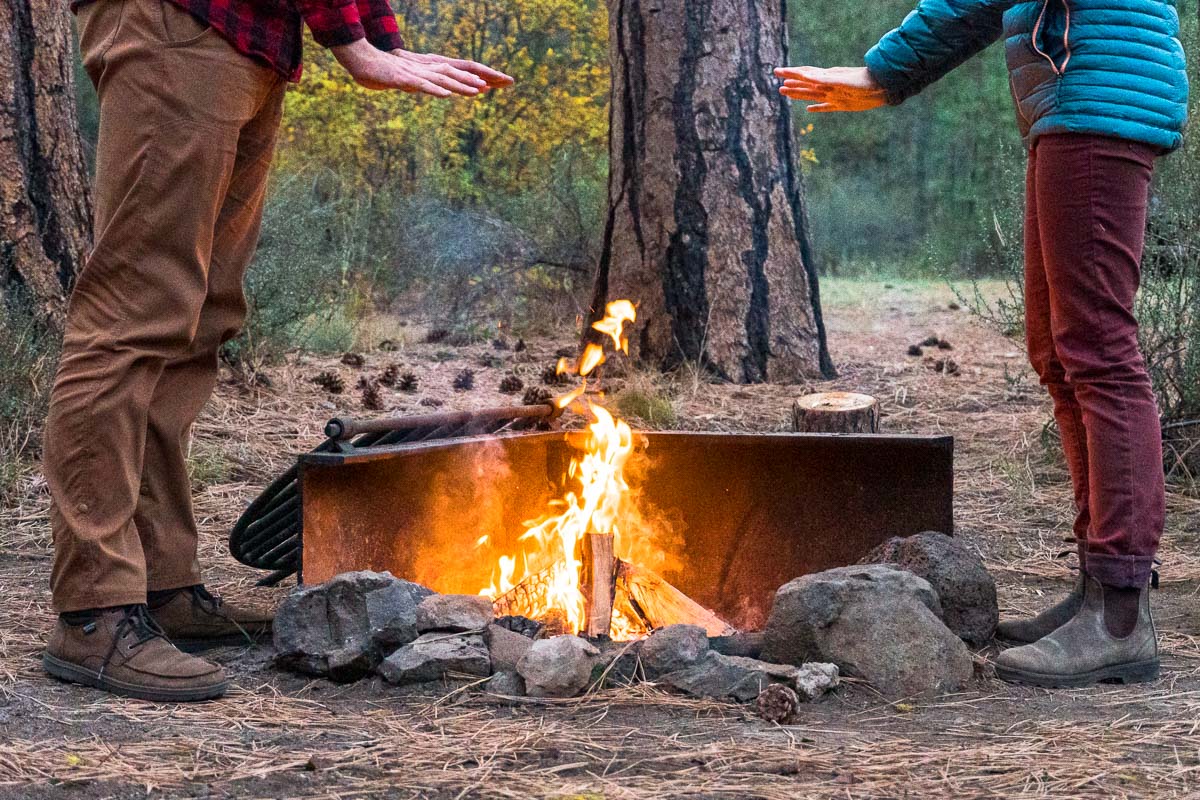
Campfire safety & tips
Fall is the perfect time for a cozy campfire. But before you get started, it’s important to familiarize yourself with a few campfire best practices.
- Check Fire Regulations First: Always confirm that fires are allowed where you’re camping. Some summer fire bans extend into fall, especially during dry years. If wood fires are prohibited, check if propane fire pits with an on/off switch are permitted. They can provide heat and ambiance without violating restrictions.
- Use Existing Fire Rings when Available: In campgrounds, build your fire only in the provided metal fire ring. When dispersed camping, reuse an existing stone fire ring rather than building a new one to minimize your impact on the landscape.
- Pick a Safe Spot: Keep your fire at least 15 feet from your tent, gear, bushes, and trees. Clear away dry leaves, pine needles, and other flammable debris since fall campsites often have extra natural fuel lying around.
- Build it Small and Manageable: Start with dry tinder and kindling, and bring fire starters as a backup if wood is damp. Keep the fire small so it is easier to control, safer, and still warm enough for cooking or hanging out.
- Prepare for Wet Conditions: Damp wood and frosty mornings can make fire-starting more difficult. Pack a hatchet for splitting logs, waterproof matches or a lighter, and fire starters so you’re not stuck with a smoky mess.
- Never Leave it Unattended: If you are going to bed, heading out for a hike, or leaving camp, make sure the fire is fully out first.
- Extinguish it Completely: Pour water over the fire, stir the ashes, and feel for heat with the back of your hand. Repeat this process until the fire is completely cold. A fire that looks out can still be smoldering underneath.
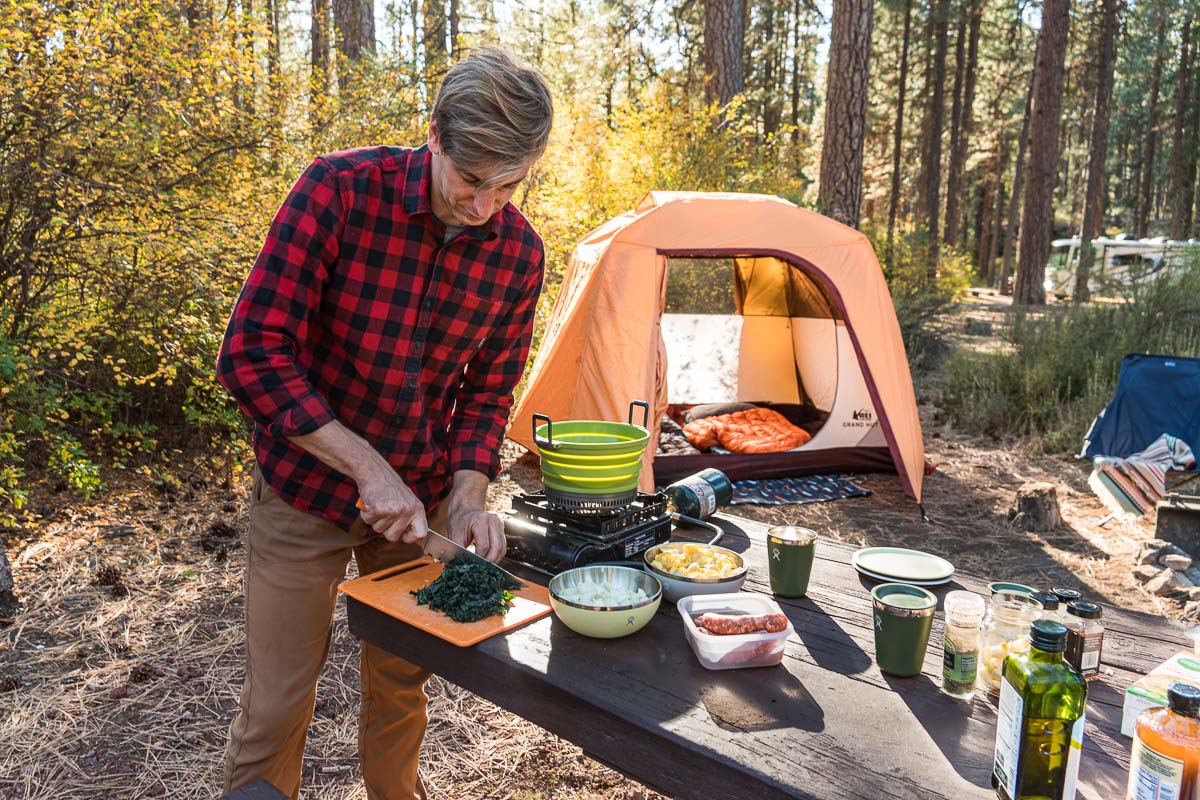
Cold weather cooking tips
We start to crave warm, hearty meals in the fall. This is also the season where we start to really enjoy cooking over the campfire!
- Choose Easy, Hearty Meals: One-pot dishes, Dutch oven recipes, and foil packet meals are perfect for fall. They’re filling, comforting, and require less cleanup at the end of the night. Here is a list of all our favorite fall camping recipes.
- Do Some Prep at Home: Since daylight is limited you’ll want meals to come together quickly, so chop, mix, or measure what you can before you leave.
- Expect Longer Cook Times: Cold air and wind can make stoves and fires less efficient. Be patient and plan for meals to take a little longer than they would in summer.
- Pack Extra Fuel: Always bring more fuel than you think you will need. Cold weather cooking, hot drinks, and longer boil times burn through fuel faster.
- Have Warm Drinks Handy: A thermos of tea, hot cocoa, or cider makes a huge difference in morale on chilly evenings and mornings.
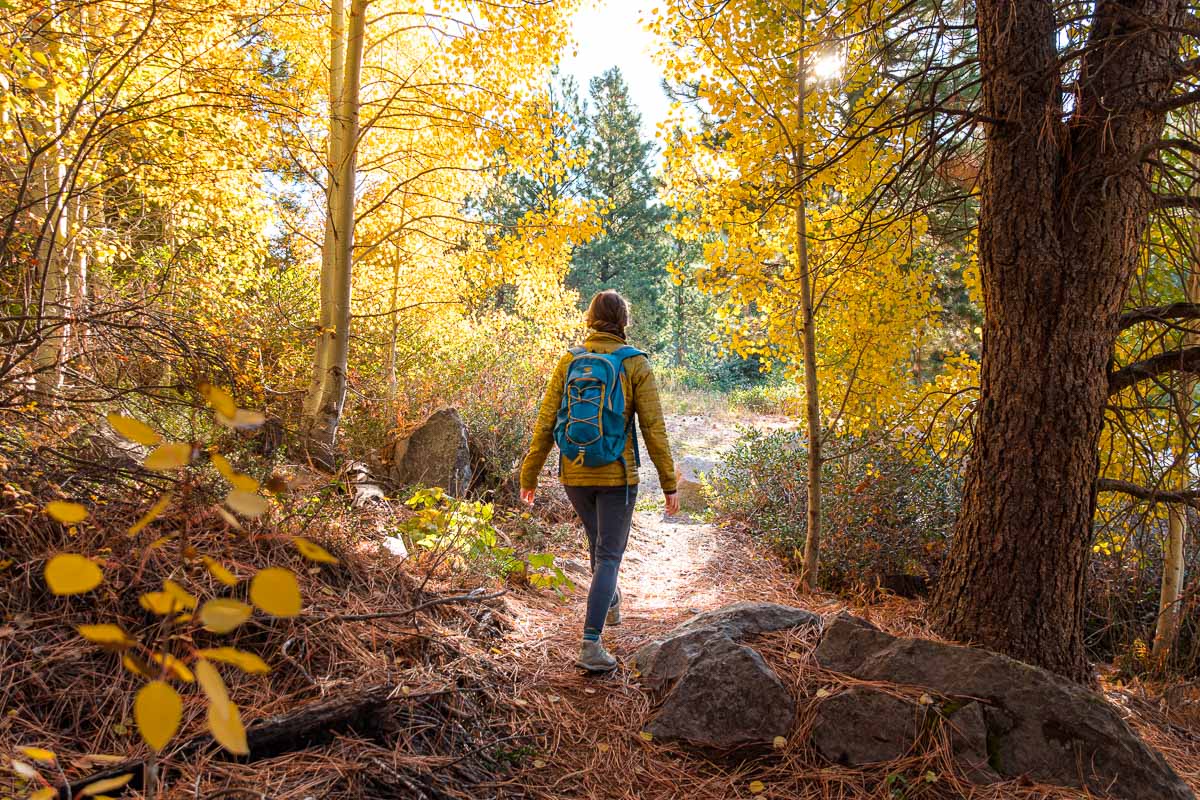
Fall camping activities
Cooler air and colorful scenery make fall one of the best times to get outside. Here are some fun ways to enjoy the season on your next camping trip:
- Hit the Trail: Hiking is at its best in the fall. Use an app like AllTrails to find nearby trails, and always pack the 10 hiking essentials. Layer up, start early to take advantage of daylight, and check out our fall hiking tips for extra safety and comfort.
- Ride Your Bike: If trails are dry, this is a great time for mountain biking or a leisurely cruise around the campground.
- Get on the Water: Kayaking or canoeing is a peaceful way to go leaf-peeping. Be sure to dress in layers that can handle splashes or breezes.
- Play Around Camp: Staying active helps you stay warm. Pack easy games like frisbee, bocce, spike ball, or a slackline. Families with kids might also enjoy scavenger hunts, nature bingo, or simply collecting colorful leaves.
- Enjoy Your Campfire: Learn how to build a Swedish fire log for a long-lasting blaze, or try cooking something new over the fire. Pie irons, foil packets, or Dutch oven desserts are especially fun this time of year.
- Seasonal Treats: Visit a nearby orchard for apple picking, then turn your haul into dessert at camp. Our Dutch oven apple cobbler and campfire apple crisp are always crowd-pleasers.
- Cozy Tent Time: Darkness falls earlier in the fall, so plan for fun after the sun sets. Bring cards, a book, a journal, or a story to share. String lights or a lantern will make your tent feel inviting so you can enjoy the evening without heading straight to bed.
Pro tip: If you’re camping with kids, pack a few extra small activities (coloring books, puzzles, storytime games) so early sunsets don’t cut the fun short.
Safety basics for fall camping
Fall camping is beautiful, but cooler weather and shorter days can introduce new challenges. A little preparation goes a long way toward keeping your trip safe, comfortable, and fun.
- Check and Double Check the Weather: Fall conditions can shift quickly. Look at the extended forecast before you go, and keep an eye on updates throughout your trip so you’re not caught off guard by sudden storms, frost, or high winds.
- Stay Hydrated: Just because it’s cooler doesn’t mean you need less water. Drinking regularly helps regulate your body temperature and keeps you warmer overall. Pack an insulated water bottle to keep drinks from freezing overnight.
- Stay Dry: Damp clothes and gear will zap body heat fast. Wear moisture-wicking layers, pack rain gear, and ventilate your tent to reduce condensation. If you do get wet, change into dry clothes immediately.
- Bring Backups of Key Items: Always pack extras of the essentials—socks, gloves, hats, and a warm layer—so you have a dry set ready if something gets soaked.
- Care for Electronics and Batteries: Cold drains batteries quickly. Keep headlamps, phones, and power banks in your sleeping bag at night or wrapped in clothing to extend their life.
- Boost Visibility: With early sunsets, reflective gear, headlamps, and high-visibility guylines will help you (and others) avoid tripping hazards around camp.
- Know the Signs of Hypothermia: Shivering, slurred speech, clumsiness, and fatigue are all red flags. If you notice these symptoms, act quickly—get dry, warm up, and seek help if needed.
- Have a Backup Plan: If conditions turn miserable, give yourself options. Eat a hot meal at a local restaurant, spend a night in a hotel or cabin, or even pack up early. If you’re not having any fun, there’s no reason to suffer through the weekend!
Pro tip: Pack a small first aid kit and keep it accessible. Even minor issues like blisters, cuts, or splinters feel worse when it’s cold, so it pays to be prepared.
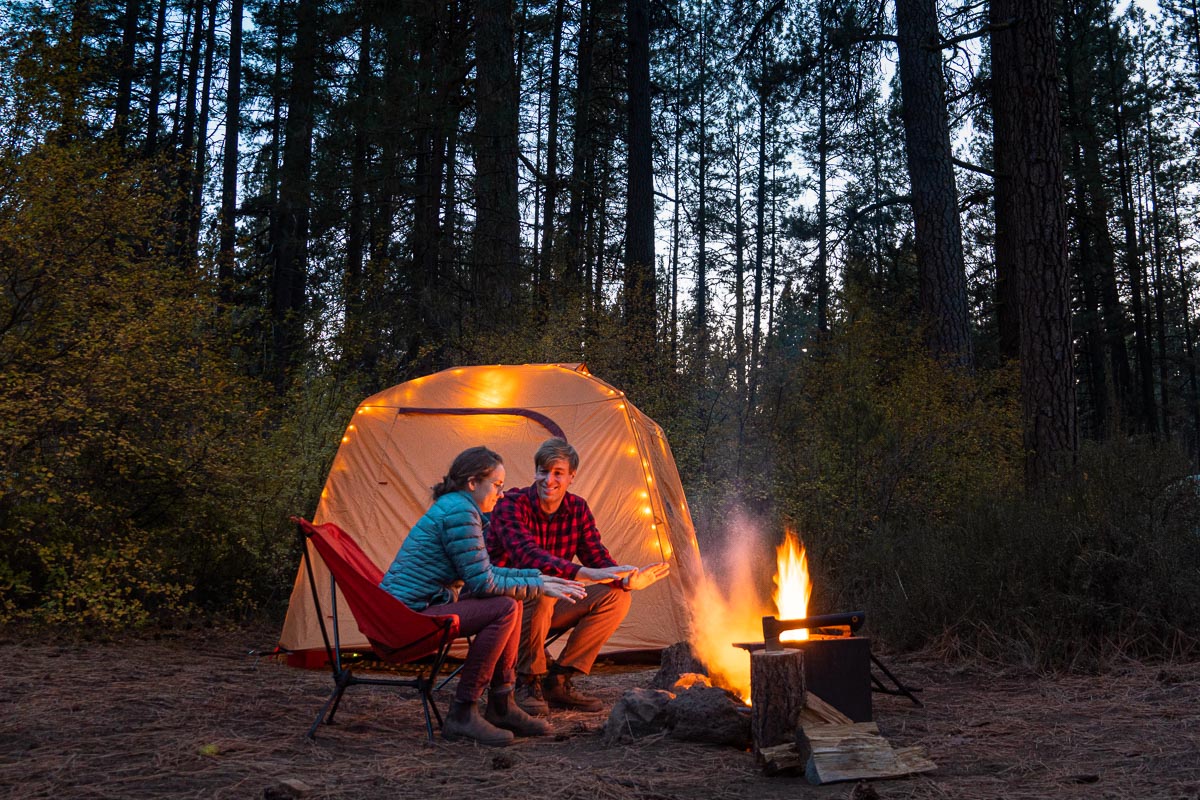
Camping in the fall takes a little more preparation than summer trips, but the payoff is worth it! Fewer crowds, cooler days, and all the beauty of the season make it an experience worth trying. With some extra layers, thoughtful meal planning, and a flexible mindset, you’ll be ready to enjoy crisp mornings, colorful scenery, and cozy evenings by the fire. We hope you have a blast!

